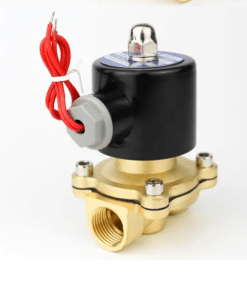Electric Solenoid Valve
Absolutely! Here’s a comprehensive guide to electric solenoid valves:
What is an Electric Solenoid Valve?
An electric solenoid valve is a type of electromechanical valve that controls the flow of fluids (liquids or gases) using an electromagnetic coil. It’s a simple, reliable, and versatile device used in a wide range of applications.
How Does it Work?
-
- Power Supply: The valve receives an electrical current.
- Electromagnetic Coil: The current passes through a coil, generating a magnetic field.
- Plunger Activation: The magnetic field attracts a metal plunger (or armature) within the valve.
- Flow Control: The movement of the plunger opens or closes a port, controlling the flow of the fluid.
Types of Electric Solenoid Valves
- Normally Closed (NC): The valve is closed by default and opens when energized.
- Normally Open (NO): The valve is open by default and closes when energized.
- Direct Acting: The plunger directly controls the flow.
- Piloted Operated: A small pilot valve controls the main valve, allowing for higher flow rates and pressures.
Applications
Electric solenoid valves are used in a vast array of industries and applications:
- Industrial Automation: Controlling fluid flow in manufacturing processes.
- Hydraulic Systems: Regulating hydraulic fluid in machinery.
- Pneumatic Systems: Controlling compressed air in pneumatic tools and equipment.
- Irrigation Systems: Automating watering schedules.
- Heating and Cooling Systems: Regulating water or refrigerant flow.
- Medical Equipment: Controlling fluid flow in medical devices.
- Automotive Systems: Controlling fuel flow and other systems.
Advantages
- Remote Control: Easily controlled through electrical signals.
- Fast Response: Quick opening and closing times.
- Reliable: Durable and long-lasting.
- Compact Size: Easy to install in various spaces.
- Versatile: Can handle a wide range of fluids and pressures.
Things to Consider When Choosing a Solenoid Valve
- Fluid Type and Pressure: Ensure compatibility with the valve’s materials and pressure rating.
- Voltage and Current: Match the valve’s electrical specifications to your power source.
- Flow Rate and Response Time: Select a valve that meets your specific requirements.
- Mounting Options: Consider the available mounting configurations (inline, panel mount, etc.)
- Environmental Factors: Choose a valve suitable for the operating environment (temperature, humidity, etc.)
Let me know if you’d like more information on a specific aspect of electric solenoid valves, or if you have any questions!
Electric Solenoid Valve
Electric Solenoid Valve 1/4″ 3/8″ 1/2″ 3/4″ 1″ DN8/10/15/20/25/50

